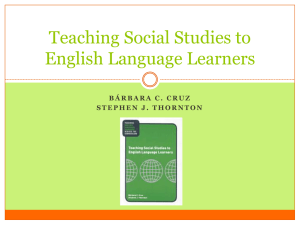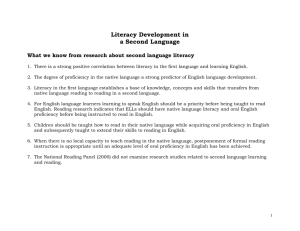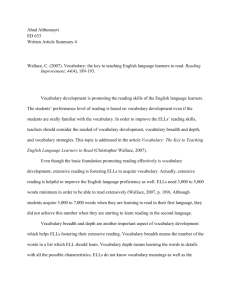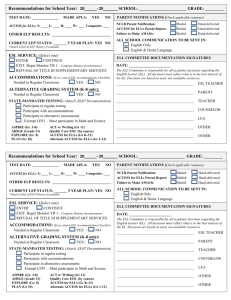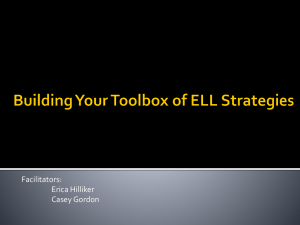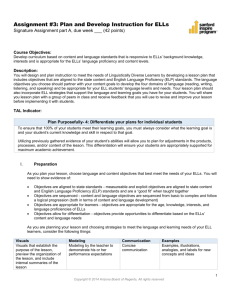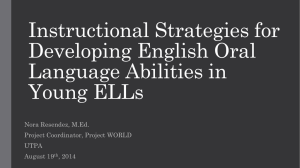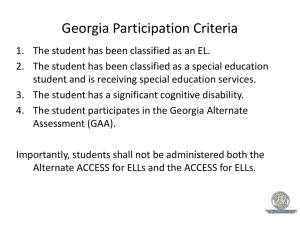Assessment with LINKS to videos - PRAXIS-Study
advertisement
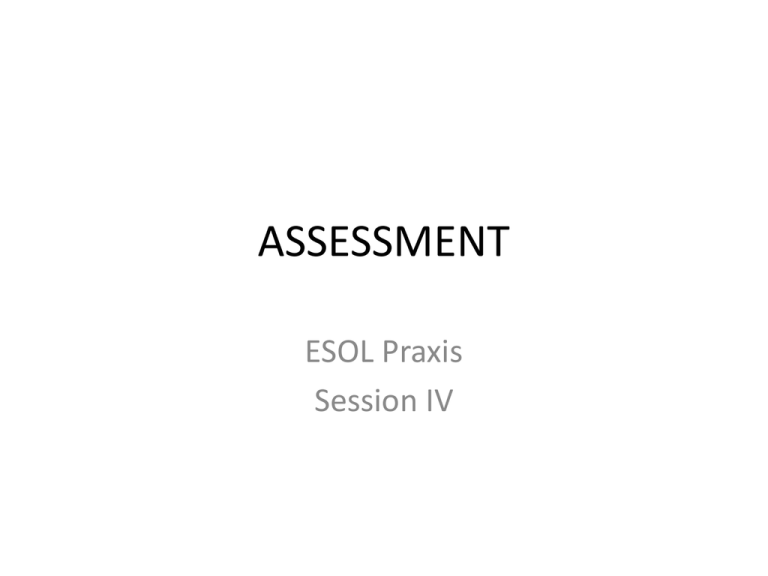
ASSESSMENT ESOL Praxis Session IV Praxis Test Content Category Number of Questions Approximate Percentage of Examination Foundations of Linguistics and Language Learning 1 48 40% Planning, Implementing, and Managing Instruction 2 36 30% Assessment 3 18 15% Cultural and Professional Aspects of the Job 4 18 15% Totals 100% Assessment Part I: Knowledge of Tests and Standards Objective 1: Is familiar with individual and group literacy assessments • State mandated tests • Commercial tests Objective 2: Is familiar with national requirements regarding ESL students’ identification, assessment, placement and exit from language-support programs • ESL students are identified by standardized assessment tests (in KS currently - KELPA) • Students entering school for the first time are given a test of language ability (KELPA-P) • May be given a one-time, one-year deferment from standardized tests during the first year • Each student must be assessed annually, and will receive services until deemed proficient Objective 3: Is familiar with methods, both formal and informal, to assess productive and receptive language skills and progress • Formal Assessment Techniques • Informal / Alternative Assessment Techniques – – – – – – – – – – Portfolio Conferences Oral Interviews Teacher Observations Documentation Self-Assessment Student Journals Story or Text Retelling Experiments and/or Demonstrations Constructed-Response Items Portfolios • A portfolio is a collection of the student’s work over time (report cards, creative writing, drawing, and so on). • Portfolios function as assessments because they: – Indicate a range of competencies and skills – Are representative of instructional goals and academic growth Portfolio Sharing • Portfolio Sharing Conferencing • Allows the instructor to evaluate a student’s progress or decline. • Students learn techniques for self-evaluation as teacher and student conference re a student’s progress Oral Interviews • Teachers use interviews to – evaluate the language students are using – to evaluate a student’s ability to provide content information when asked questions – Evaluate student’s level of English proficiency – Identify potential problem areas that may require correctional strategies • Information gathered is then used in planning for instruction Teacher Observations • The teacher observes the student behavior during an individual or group activity. • Before beginning the activity, the instructor may want to create a numerical scale to rate desired outcomes. Documentation • Similar to teacher observations • Documentation takes place over a period of time rather than as isolated observations Self-Assessment • Students begin to think for themselves • Teachers provide guidance and criteria related to success Student Journals • Journals function as a record of student progress • Journals promote inner dialogue Story or Text Retelling • Students respond orally and can be assessed on how well they describe events in the story • Students can also be assessed on their response to the story and their language proficiency Experiments / Demonstrations • Students complete an experiment or demonstration and present it through an oral or written report. • Students are evaluated on their understanding of the concept, explanation of the scientific method, and/or their language proficiency. Constructed-Response Items • Students respond to writing in open-ended questions. • Focuses on how students apply information rather on how much they recall of content lessons. • In this assessment, students may create a semantic map, write a brief comment on a couple points made in the readings, or write an essay discussing or evaluating the material. Objective 4: Is able to identify, select and/or develop assessments to determine English-language learners’ language skills • Language has over 200 dimensions that can be evaluated; yet most tests assess less than 12 of them. Use with caution, and always back up with teacher observations, interviews and other available data. – Language Placement Tests: Designed to place a student within a specific program. (KELPA-P) – Language Proficiency Tests: Measures how well students have met certain standards in a particular language. – Diagnostic Language Tests: Designed to identify individual students’ strengths and weaknesses. Objective 5: Is familiar with assessments that measure English-language learners’ progress toward meeting state and national standards Language Achievement Tests: • Related directly to a specific curriculum or course of study. • Includes language sub-skills, reading comprehension, parts of speech, and other mechanical parts of the language such as spelling, punctuation and paragraphing. • Possible examples: unit exams, final exams Objective 6: Familiar with formal and informal techniques that may be used to assess students’ content-area learning at varying levels of language and literacy development Formal Assessment Techniques: • Used to evaluate students in content areas and in language skills. Most states have standardized tests that are given to all students at intervals throughout the years. • High stakes testing has raised the bar. Students are tested to exit high school, for school districts to receive state and federal funding and to grade school performances. One Informal Technique: Teacher Observation / Discussion • Alternative Assessment with Discussion Skills Peer-Assessment Techniques: • ELLs need to practice peer assessment with a partner. • Use reference card or rubrics to evaluate the strengths and weaknesses of the assignment (or a part of the assignment). • After reviewing each other’s work together, each partner corrects his or her own assignment. Assessment Part II: Appropriate Uses of Tests Objective 1: Skilled at making accommodations for students with limited English proficiency Accommodations: • For ELLs, cultural and linguistic biases exist in testing. The unfortunate result may be that their true level is incorrectly reported. • Possible accommodations: – Additional time – Bilingual dictionary – Read specific parts to students – Provide pronunciation and word mean help Objective 2: Able to identify ESL students with special education and/or gifted and talented needs and refer those students for services Special Education: • Some of the characteristics of ELLs seem to be the same characteristic as those with learning disabilities. • ELLs are over-represented in exceptional groupings. • Students may show apparent processing difficulties, behavioral differences, reading difficulties, and expressive difficulties. • Careful observation and documentation is needed. Individualized Education Plan (IEP) • All exceptional students must have an IEP, which is a legally binding document for the school and any teacher working with the student • Specific instructions for dealing with an individual’s exceptionality should be spelled out in the IEP. Teaching Practices • • • • Use multiple instruction and assessment strategies Combine lectures with other instructional strategies Objectives should be posted and student centered Differentiate content, process, product, and assessment • Students may need to prepare for test taking because this is a stressful activity for many ELLs. Use alternative or modified assessments where possible – – – – – reduce number of choices on multiple choice tests use cloze tests give students partial outlines for essay tests give a selection of choices for blank spaces in tests gradually reduce the amount of scaffolding for successful students Gifted ELLs • Characteristics: – Successful history in previous school setting – Advanced development history – Rapid learning – Solves complex problems that are not dependent on English – High academic performance in L1 – Successful history in environment for L1 is required Objective 3: Familiar with assessment-related issues such as validity, reliability, language and cultural bias, and scoring concerns. • ELLs who are not familiar with assessment in the U.S. may experience difficulty adjusting to the following – – – – Standard testing techniques Inability to ask questions of the teacher Testing time constraints Inability to work on a specific section of a test • Testing accommodations need to be introduced in the regular classroom, so that ELLs and other students are familiar and comfortable with the accommodations before the testing session begins. Validity • An assessment test can be considered valid only if it measures what it asserts to measure. • Predictive Empirical Validity: Concerns the possible outcomes of test performance • Concurrent Empirical Validity: connected with another variable for measurement Four Types of Bias • Cultural Bias: concerns knowledge acquired from participating in and sharing certain cultural values and experiences. • Attitudinal Bias: refers to the negative attitude of the examiner towards a certain language, dialect, or culture. • Test Bias or Norming Bias: Excluding populations used to obtain norm results. • Translation Bias: Test is literally translated from L2 to L1 by interpreters or other means. Reliability • An assessment can only be considered reliable if similar scores result when the test is taken a second time. • Emotional or environmental factors (anxiety, hunger, fatigue, temperature) should not cause a huge fluctuation in the learner’s score. Practicality • A test that proves to be both valid and reliable may unfortunately prove to be cost- or timeprohibitive. • The ideal assessment is one that is easy to administer and to grade, as well as one that includes testing items similar to ones the learners experienced in class. • Example: a writing journal is an excellent method for tracking language achievement progress, but can be difficult to grade due to subjective content. Test Types • Norm-Referenced Tests: tests in which the results are interpreted based on the performance of a given group, the norm. (Grading on the curve) • Criterion-Referenced Tests: tests in which the individual’s test score is based on the mastery of the course content. Categories of Tests • First Generation Tests: approximate the grammartranslation approach to teaching language, where the student is asked to perform tasks. (Devoid of context and not authentic) • Second Generation Tests: based on discrete points, are typically very long, and many of the items may have no connection with each other. (Traditional Tests) • Third Generation Tests: Based upon the communicative principals and by their very nature, are authentic. (Performance-Based Tests) Assessment Part III: Interpreting and Applying Assessment Results Objective 1: Skilled at using assessment results to plan and differentiate instruction • Modify and differentiate instruction with all students • Only the teacher can analyze the data and set new goals for success • Differentiated Instruction: Teachers decide what all students will learn about a topic, what some students will learn, and what few students will learn. • Teachers use scaffolding techniques with ELLs by helping students focus on the key parts of an assignment. Through questioning, teachers provide opportunities for students to verbalize what they know (or demonstrate what they do not know) about the task. Objective 2: Able to use assessment results to inform a variety of decisions (e.g., placement, advancement, exit) • Evaluation: Different states have different tests for the evaluation of their incoming students (in Kansas, it’s the KELPA-P) • Classification: Based upon the results of these tests, students may be classified as ELLs who are fully proficient in the English language or as ELLs needing supplementary language services. • Annual Testing: Once a student is classified as ELL, annual testing is given to monitor the progress of the student in the English language learning and for possible reclassification (advancement) or exiting the program. • Reclassification or Exiting: When students are being considered for reclassification or to exit the program, other measures are considered – Student’s performance in basic skills – Teacher evaluations – Parent or guardian opinion and consultation Objective 3: Interpret and communicate the results of assessments to English-language learners and their parents • Parents must be informed of: – AYP of their school – School designation information – Pertinent information concerning Title 1 parents – Pertinent information regarding ELLs • This information must be in the native language when possible. Assessment Strategies • Elementary Strategies • Secondary Strategies

